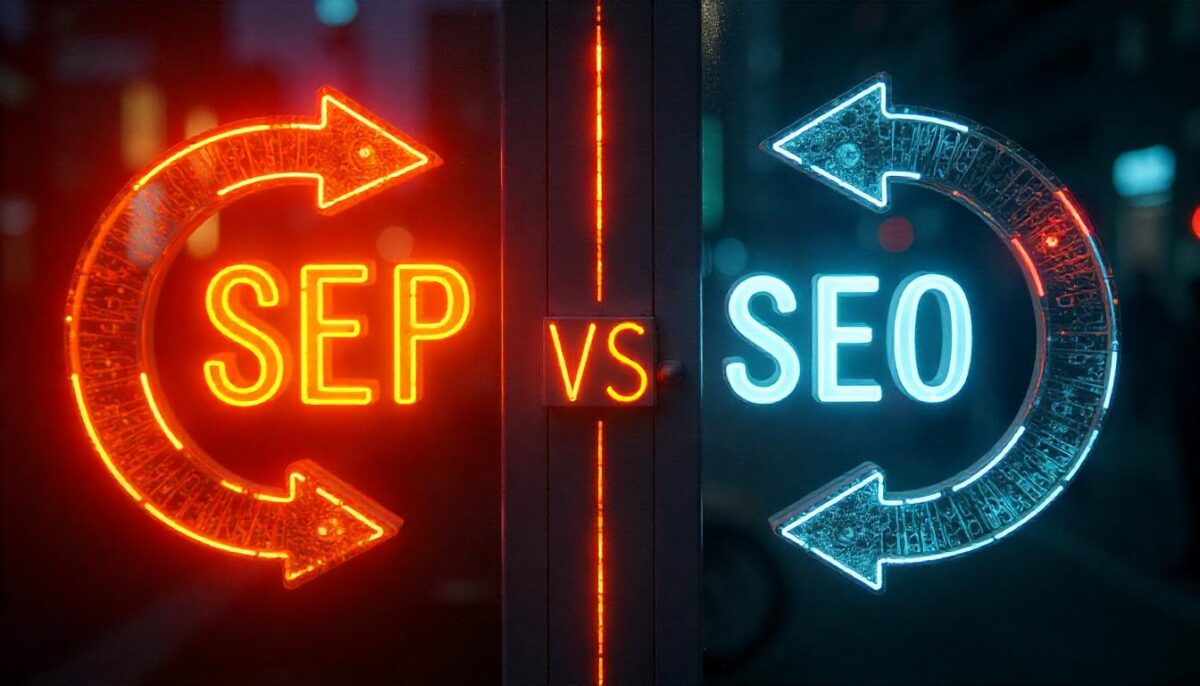The constant evolution of SEO results in the constant emergence of new terms and strategies, and while some are widely accepted as standard and reserve a permanent place for themselves in SEO diction, others prove to be no more than vanity-filled and vain attempts to kickstart a notion or term.
One SEO term that’s been doing the rounds for a while, and one that grabs immediate attention due to its close resemblance to it, is Search Engine Positioning, or SEP.
In this post, experts and leaders from the BoostMyDomain community explore what SEP is all about, and let us in on the differences or similarities it shares with SEO.
Read on!
Refining the Art of Visibility
From my perspective, Search Engine Positioning isn’t a brand-new evolution of SEO – it’s a more targeted refinement of the core practices we’ve been working with for years.
At its heart, it’s about focusing on not just getting found, but dominating a specific position for high-value keywords. It builds on the foundation of SEO but requires a sharper, more intentional strategy to meet the demands of today’s competitive and ever-changing search landscape.
For example, at Resilient Stories, we’ve adapted our content strategies to prioritize visibility in key areas like featured snippets-spaces that can connect us with our audience in the most impactful way.
This isn’t just traditional SEO; it’s about identifying where our audience is searching and optimizing to meet them there, whether that means ranking for “resilience in storytelling” or appearing in the “People Also Ask” sections for topics related to personal growth.
What sets Search Engine Positioning apart for me is the role of real-time adaptability and intent-driven content. It’s not just about stuffing keywords into an article anymore; it’s about crafting content that answers specific, nuanced questions while incorporating analytics to refine and sustain those positions.
For example, we’ve started experimenting with AI tools to analyze search behavior, identify trending queries, and personalize our content to anticipate what readers are looking for.
In my view, Search Engine Positioning represents an exciting opportunity for content creators to go beyond broad visibility and aim for precision. It’s still grounded in the fundamentals of SEO but with a clearer focus on owning the moments and spaces that matter most to your audience.

Danielle Dahl
Co-Founder, Resilient Stories
Strategic Approach to Gaining Prime Positions
Search Engine Positioning (SEP) is not just a rebranding of traditional SEO but a more refined, strategic approach to gaining and maintaining prime positions on search engine results pages (SERPs). Let me share a story that illustrates the difference.
Hyper-Targeted Keyword Strategy
Traditional SEO targets broad keywords, but SEP zooms in on niche, long-tail keywords. For example, instead of “project management software,” target “project management tools for remote teams.” This strategy attracts a more specific, high-converting audience.
Tip: Focus on long-tail, high-intent keywords that match user needs.
SERP Feature Optimization
SEP prioritizes ranking for SERP features like rich snippets and knowledge panels. Structuring content to directly answer questions can help secure these spots and increase visibility.
Tip: Format content to provide clear, concise answers to common queries.
Continuous Competitive Analysis
SEP requires regularly monitoring competitors and adjusting your strategy. It’s not just about ranking; it’s about outperforming them by filling content gaps and adjusting to algorithm changes.
Tip: Keep track of competitors’ content and adjust your tactics accordingly.
With SEP, it’s about not just getting to the top but staying there. Constant optimization and competitor tracking are key to maintaining a strong position.
Search Engine Positioning is about strategic ranking and retaining your spot. By focusing on niche keywords, optimizing for SERP features, and monitoring competitors, SEP takes SEO beyond basic rankings.
Actionable Takeaway: Start by refining your keyword strategy with long-tail, niche keywords. Focus on optimizing for featured snippets and continually analyze competitors to stay ahead in the race.

Vishal Shah
Sr. Technical Consultant, WPWeb Infotech
Targeted Visibility Beyond General Rankings
Search Engine Positioning (SEP) feels like a natural evolution of SEO, especially in our experience as a motion graphics company. It goes beyond general rankings to focus on targeted visibility, helping us appear in searches like “best animated explainer video agency.” SEP ensures our portfolio site is fast, responsive, and engaging-critical for showcasing our visually dynamic work. It’s not just about being found; it’s about delivering an experience that resonates with potential clients.
For us, SEP has also meant optimizing across platforms like YouTube, where video SEO is key to reaching the right audience. We’ve adopted hyper-localized strategies, tailoring content to specific industries and regions to connect with clients on a personal level. By combining these techniques with real-time analytics, SEP helps us stay ahead, ensuring our creative work reaches the people who need it most while positioning us as leaders in motion graphics.

Dewi Saklina
Search Engine Optimization Specialist, Explainerd
Holistic View of User Experience
Search Engine Positioning feels more like an evolution of SEO rather than just a rebranding. While traditional SEO focuses on optimizing content for keywords, Search Engine Positioning takes a broader approach by focusing on the overall user experience and how different factors influence rankings.
For example, it looks at things like site speed, mobile optimization, and user intent-elements that weren’t as heavily prioritized in older SEO practices. One innovative strategy I’ve seen is optimizing content around user queries rather than just keywords. Instead of targeting a single keyword, you focus on answering the specific questions people are asking. This approach not only helps with ranking but also improves the quality of traffic you get, leading to better engagement. So, while the core principles remain the same, the focus has shifted to a more holistic view of user experience and satisfaction.

Adnan Jiwani
Assistant Manager Digital Marketing, PureVPN
User-First Approach Focused on Relevance
Search Engine Positioning (SEP) is more than rebranded SEO – it’s ultimately a user-first approach that’s focussed on relevance and intent. While SEO aims for visibility, SEP ensures you’re the right answer at just the right time.
A friend’s travel agency once chased broad terms like “holiday packages” with little success. Shifting to intent-driven phrases like “tailored family safaris” attracted fewer clicks but far more bookings. That’s SEP: prioritising quality over quantity by connecting with users ready to act.
Unlike traditional SEO, SEP centres on user needs, mastering features like local packs and snippets while delivering fast, engaging experiences. It’s not just about being seen – it’s more about being the solution.

SEO Consultant, The SEO Consultant Agency
Precise SERP Rankings for Specific Queries
Search Engine Positioning refines SEO by focusing on precise SERP rankings. For example, a local bakery targeting “best cupcakes in Los Angeles” would create optimized content tailored to this keyword, improve local SEO signals like Google My Business updates, and analyze competitors already ranking for the term. Unlike broader SEO efforts, the strategy zeroes in on pushing a specific page higher in rankings for a specific query. Techniques like hyper-focused keyword targeting, intent-based content creation, and competitor benchmarking set it apart, ensuring measurable improvements in achieving top positions for high-intent searches. It’s a targeted evolution of traditional SEO methods.

Muhammad Nurul Afsar
SEO Manager, Numinix
Natural Part of SEO for Lead Generation
For me, Search Engine Positioning has always been a natural and integral part of SEO. For example, in the Software Development niche, where I have been working for over 8 years, it is crucial to ensure that specific service pages of a company rank at least in the top-3 to consistently generate leads from search. In this niche, clients often prefer working with market leaders, which becomes evident both from many initial queries and during further communication with clients.
It’s clear that a website may have hundreds or even thousands of pages, but often this serves as the necessary ‘muscle mass’ to build sufficient topical authority and support the pages that generate business value. Thus, by focusing on promoting a specific service or product to top positions, you inevitably arrive at Search Engine Positioning.
In certain cases, achieving top rankings has required me to launch a series of experiments, including user testing or even restructuring the website to highlight the promoted direction as a dedicated cluster. This often involves rethinking website elements to adapt the content to the user journey of a specific audience.

Ulad Yanouski
SEO Team Lead, Vention
Mastering Fundamentals with Modern Priorities
A common mistake is viewing Search Engine Positioning (SEP) as entirely new. It’s an evolution of traditional SEO, combining fundamentals like keywords and backlinks with Google’s modern priorities-semantics, EEAT (Expertise, Authoritativeness, Trustworthiness), and brand building. Google prioritizes brands and context over individual keywords, making semantic relevance critical. Content must address the user’s full intent, not just specific terms, to rank higher.
Another pitfall is chasing buzzwords like AI and machine learning while ignoring essentials like page speed, mobile-friendliness, and internal linking. Small tweaks, like refining content structure or meta descriptions, can improve rankings.
In my experience, ranking success now requires positioning your site as an authoritative, trustworthy brand by covering topics comprehensively and ensuring relevance through semantic optimization. SEP is mastering fundamentals while adapting to how Google evaluates content holistically today.

Abdul Samad
SEO Specialist, Enterprise64
Evolution with Advanced Data Analysis
As the owner of an SEO agency and an SEO specialist, I believe Search Engine Positioning (SEP) is more of an evolution than a rebranding of traditional SEO. While SEO has always focused on improving a website’s visibility in search engine results, SEP adds a more strategic and holistic approach. It combines traditional SEO techniques with advanced data analysis, user intent mapping, and continuous optimization, making it more dynamic. Instead of simply focusing on rankings, SEP emphasizes aligning content and strategies with the overall user experience and search engine algorithms’ evolving complexity. This shift is about long-term sustainable growth, not just short-term wins.
Innovative methodologies that distinguish SEP from traditional SEO include leveraging AI and machine learning to understand user behavior more accurately, enhancing content personalization, and using automation tools to improve efficiency. These innovations allow for better targeting, faster adaptation to algorithm updates, and improved content relevance. As an SEO expert, I see SEP as the next logical step in optimizing websites for both users and search engines, reflecting the industry’s continuous progression toward smarter, data-driven practices.

Greg Walters
Co-Founder, SEO Modify
Semantic SEO Enhances Relevance and Context
Search Engine Positioning is less about rebranding and more about a refined approach to SEO, with Semantic SEO playing an important role. Unlike traditional SEO, which focuses heavily on keywords and backlinks, Semantic SEO emphasizes creating content that aligns with user intent and context by covering topics comprehensively.
By leveraging structured data, entity-based optimization, and natural language processing (NLP), Semantic SEO enhances a website’s relevance to both search engines and users. This strategy is vital for Search Engine Positioning, as it helps improve rankings for nuanced, intent-driven queries that traditional SEO might overlook.
In essence, Search Engine Positioning builds on the foundation of SEO but evolves it into a contextual and user-focused discipline, ensuring higher visibility in competitive niches while staying aligned with modern algorithm updates.

Harsh Johri
Search Engine Optimizer, Huptech Web
The BoostMyDomain team thanks these experts and leaders for taking the time to share their valuable insights on search engine positioning and how it is different from our traditional viewpoint of SEO.
BoostMyDomain invites you to share your insights and contribute to our authoritative publication. Reach a wider audience, build your credibility, and establish yourself as a thought leader in an industry that caters to every business with an online presence!
